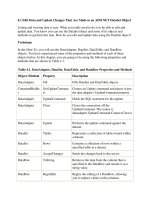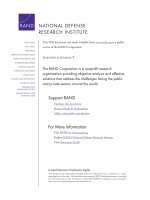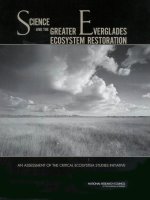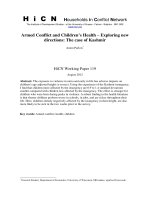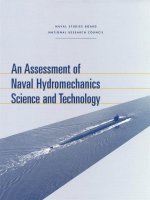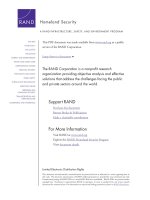Wind tunnel and propulsion test facilities supporting analyses to an assessment of nasa docx
Bạn đang xem bản rút gọn của tài liệu. Xem và tải ngay bản đầy đủ của tài liệu tại đây (691.06 KB, 164 trang )
This PDF document was made available from www.rand.org as a public
service of the RAND Corporation.
6
Jump down to document
Visit RAND at www.rand.org
Explore RAND National Defense Research Institute
View
document details
This document and trademark(s) contained herein are protected by law as indicated in a notice
appearing later in this work. This electronic representation of RAND intellectual property is provided
for non-commercial use only. Permission is required from RAND to reproduce, or reuse in another
form, any of our research documents for commercial use.
Limited Electronic Distribution Rights
For More Information
CHILD POLICY
CIVIL JUSTICE
EDUCATIO
N
ENERGY AND ENVIRONMENT
HEALTH AND HEALTH CAR
E
INTERNATIONAL AFFAIR
S
NATIONAL SECURIT
Y
POPULATION AND AGIN
G
PUBLIC SAFETY
SCIENCE AND TECHNOLOGY
SUBSTANCE ABUSE
TERRORISM AND
HOMELAND SECURITY
TRANSPORTATION AND
INFRASTRUCTURE
The RAND Corporation is a nonprofit research
organization providing objective analysis and effective
solutions that address the challenges facing the public
and private sectors around the world.
Purchase this document
Browse Books & Publications
Make a charitable contributio
n
Support RAND
This product is part of the RAND Corporation technical report series. Reports may
include research findings on a specific topic that is limited in scope; present discus
-
sions of the methodology employed in research; provide literature reviews, survey
instruments, modeling exercises, guidelines for practitioners and research profes
-
sionals, and supporting documentation; or deliver preliminary findings. All RAND
reports undergo rigorous peer review to ensure that they meet high standards for re
-
search quality and objectivity.
7IND4UNNELAND
0ROPULSION4EST&ACILITIES
3UPPORTING!NALYSESTOAN
!SSESSMENTOF.!3!S
#APABILITIESTO3ERVE
.ATIONAL.EEDS
0HILIP3!NTØN$ANA**OHNSON-ICHAEL"LOCK
-ICHAEL"ROWN*EFFREY$REZNER*AMES$RYDEN
%UGENE#'RITTON4OM(AMILTON4HOR(OGAN
2ICHARD-ESIC$EBORAH0EETZ2AJ2AMAN
0AUL3TEINBERG*OE3TRONG7ILLIAM4RIMBLE
0REPAREDFORTHE.ATIONAL!ERONAUTICSAND3PACE!DMINISTRATIONAND
THE/FFICEOFTHE3ECRETARYOF$EFENSE
!PPROVEDFORPUBLICRELEASEDISTRIBUTIONUNLIMITED
4HE 2!.$#ORPORATION ISA NONPROFITRESEARCH ORGANIZATIONPROVIDINGOBJECTIVEANALYSIS
AND EFFECTIVE SOLUTIONSTHAT ADDRESS THECHALLENGES FACINGTHEPUBLICANDPRIVATE SECTORS
AROUNDTHEWORLD2!.$SPUBLICATIONSDONOTNECESSARILYREFLECTTHEOPINIONSOFITSRESEARCH
CLIENTSANDSPONSORS
®
ISAREGISTEREDTRADEMARK
Ú#OPYRIGHT2!.$#ORPORATION
!LLRIGHTSRESERVED.OPARTOFTHISBOOKMAYBEREPRODUCEDINANYFORMBYANYELECTRONICOR
MECHANICALMEANSINCLUDINGPHOTOCOPYINGRECORDINGORINFORMATIONSTORAGEANDRETRIEVAL
WITHOUTPERMISSIONINWRITINGFROM2!.$
0UBLISHEDBYTHE2!.$#ORPORATION
-AIN3TREET0/"OX3ANTA-ONICA#!
3OUTH(AYES3TREET!RLINGTON6!
.ORTH#RAIG3TREET3UITE0ITTSBURGH0!
2!.$52,HTTPWWWRANDORG
4OORDER2!.$DOCUMENTSORTOOBTAINADDITIONALINFORMATIONCONTACT
$ISTRIBUTION3ERVICES4ELEPHONE
&AX%MAILORDER RANDORG
,IBRARYOF#ONGRESS#ATALOGINGIN0UBLICATION$ATA
7INDTUNNELANDPROPULSIONTESTFACILITIESSUPPORTINGANALYSESTOANASSESSMENTOF.!3!SCAPABILITIESTOSERVE
NATIONALNEEDS0HILIP3!NTON;ETAL=
PCM
h42v
)NCLUDESBIBLIOGRAPHICALREFERENCES
)3".PBKALKPAPER
7INDTUNNELS5NITED3TATES.ATIONAL!ERONAUTICSAND3PACE!DMINISTRATION2ESEARCH
!ERONAUTICS2ESEARCH5NITED3TATES!IRPLANES5NITED3TATES4ESTING!IRPLANES5NITED3TATES*ET
PROPULSION)!NTN0HILIP3
4,773UPPL
gDC
4HERESEARCHDESCRIBEDINTHISREPORTWASPREPAREDFORTHE.ATIONAL!ERONAUTICSAND3PACE
!DMINISTRATIONAND THE /FFICE OFTHE 3ECRETARY OF$EFENSE /3$4HE RESEARCH WAS
CONDUCTEDINTHE2!.$.ATIONAL $EFENSE 2ESEARCH)NSTITUTE AFEDERALLY FUNDEDRESEARCH
ANDDEVELOPMENTCENTERSUPPORTEDBYTHE/3$THE*OINT3TAFFTHEUNIFIEDCOMMANDSAND
THEDEFENSEAGENCIESUNDER#ONTRACT$!37#
iii
Preface
This technical report provides detailed data, observations, and conclusions from a one-year
study (from June 2002 through July 2003) examining the nation’s wind tunnel and propul-
sion testing needs and the continuing ability that National Aeronautic and Space Admini-
stration’s (NASA’s) major wind tunnel (WT) and propulsion test (PT) facilities
1
have in
serving those needs, identifying new investments needed and any excess capacities within
NASA.
This report should be of interest to those in the research development test and
evaluation community in NASA, the Department of Defense, and the aerospace industry
seeking detailed insights into national needs for WT/PT facility testing, NASA’s facilities,
and technical considerations for selected non-NASA facilities important to national needs.
The report serves as a companion and supports the following monograph:
Antón, Philip S., Richard Mesic, Eugene C. Gritton, and Paul Steinberg, with Dana J. Johnson,
Michael Block, Michael Brown, Jeffrey Drezner, James Dryden, Tom Hamilton, Thor Hogan,
Deborah Peetz, Raj Raman, Joe Strong, and William Trimble, Wind Tunnel and Propulsion Test
Facilities: An Assessment of NASA’s Capabilities to Meet National Needs, Santa Monica, Calif.:
RAND Corporation, MG-178-NASA/OSD, 2004 (referred throughout this report as Anton et al.,
2004[MG]).
The study was funded by NASA and jointly sponsored by NASA and the office of
the Director, Defense Research and Engineering (DDR&E). It was conducted within the
RAND National Defense Research Institute’s (NDRI’s) Acquisition and Technology Policy
Center. NDRI is a federally funded research and development center sponsored by the
Office of the Secretary of Defense, the Joint Staff, the unified commands, and the defense
agencies.
____________
1
Throughout this report, we use the term “WT/PT facilities” to mean wind tunnel facilities and propulsion test facilities,
that is, the type of NASA facilities we assessed. Since individual facilities within this designation can be either wind tunnel
facilities, propulsion test facilities, or both, “WT/PT facilities” serves as a generic term to encompass them all. That being
said, when a specific facility is talked about, for clarity, we refer to it as a proper name and, if necessary, include its function
(e.g., Ames 12-Foot Pressure Wind Tunnel). As well, the term “test facilities” and “facilities” can be substituted to mean
“WT/PT facilities.” Of course, NASA owns and operates other types of test facilities outside of WT/PT facilities, but our
conclusions and recommendations do not apply to them.
v
Contents
Preface iii
Figures
ix
Tables
xi
Summary
xiii
Acknowledgments
xix
Abbreviations
xxi
CHAPTER ONE
Introduction 1
Approach
1
Perspectives on the Approach
2
Scope of the Study
3
WT/PT Facility Management Issues
4
The Effects of NASA’s Center-Centric Organization on WT/PT Facility Support
4
The Effects of Current Low Utilization on Facility Financial Status
5
Periodic Reviews of Facility Health
6
Additional Cost/Benefit Perspectives
6
Organizational Structure of This Technical Report
8
CHAPTER TWO
National Wind Tunnel and Propulsion Test Facility Needs and NASA’s Primary Facilities
Serving These Needs
9
Strategic Needs Drive Vehicle Research and Production
9
Vehicle Research and Production Result in Test Facilities Needs
9
Technical Needs and Vehicle Types Differ by Sector: NASA, DoD, and Commercial
11
Research, Design, and Production Issues for Vehicles
12
Testing Needs Covered a Broad Range of Test Types
14
Specific Testing Needs Today
15
Flow Physics Situations and Issues for Aerospace Testing
16
Hypersonic Propulsion Integration Needs
18
Identifiable Needs in Existing Test Plans
20
Complementary Testing Approaches and Their Effect on Test Facilities: Computational Fluid
Dynamics and Flight Testing
22
CFD Has Reduced Some WT/PT Facility Testing Needs, but Only in Specific Areas
22
Flight Testing Remains Unfeasible for Design Data Needs for Most Vehicles
23
Factors Influencing Actual Facility Utilizations
24
vi WT/PT Facilities: Supporting Analyses to an Assessment of NASA’s Capabilities to Serve National Needs
NASA’s Primary WT/PT Facilities for Nation’s Needs 24
On Facilities as Backups
27
Upgrades and New Facilities Needed
27
Needed Improvements to Conventional WT/PT Facilities
28
New Facilities?
28
NASA WT/PT Facilities Are Generally Consistent with U.S. Needs, but Some Investments
Are Needed
28
CHAPTER THREE
Subsonic Wind Tunnels 33
Health Ratings for Test Facilities
38
Subsonic WT Health Ratings and Summary Descriptions
40
General-Purpose High-Rn Subsonic WTs
41
Ames 12-Foot Pressure Wind Tunnel
41
General-Purpose Atmospheric Subsonic WTs
43
Langley 1422-Foot Subsonic Wind Tunnel
43
Langley 12-Foot Wind Tunnel Laboratory
44
Special-Purpose Subsonic WTs
45
Ames National Full-Scale Aerodynamics Complex
45
Glenn Icing Research Tunnel
48
Glenn 915-Foot Propulsion Wind Tunnel
48
Langley 20-Foot Vertical Spin Tunnel
49
Langley Low-Turbulence Pressure Tunnel
49
Conclusions and Recommendations for Existing Subsonic WTs
50
CHAPTER FOUR
Transonic Wind Tunnels 51
Transonic WT Health Ratings and Summary Descriptions
54
General-Purpose, High-Rn Transonic WTs
54
Ames 11-Foot Transonic Unitary Plan Wind Tunnel
54
AEDC 16T Propulsion Wind Tunnel
56
Langley National Transonic Facility
56
Special-Purpose Transonic WTs
57
Langley Transonic Dynamics Tunnel
57
Glenn 86-Foot Propulsion Wind Tunnel
59
Langley 16-Foot Transonic Tunnel
59
AEDC 4-Foot Transonic Wind Tunnel
59
Conclusions and Recommendations for Existing Transonic WTs
60
CHAPTER FIVE
Supersonic Wind Tunnels 63
Supersonic WT Health Ratings and Summary Descriptions
65
General-Purpose, High-Rn Supersonic WTs
66
Ames 97-Foot Supersonic Unitary Plan Wind Tunnel
66
AEDC 16-Foot Supersonic Wind Tunnel
67
Small High-Rn Supersonic WTs
68
Contents vii
Langley 4-Foot Supersonic Unitary Plan Wind Tunnel 68
Special-Purpose Supersonic WTs
68
Glenn 1010-Foot Supersonic Wind Tunnel
68
AEDC von Karman Gas Dynamics Facility Wind Tunnel A
70
Conclusions and Recommendations for Existing Supersonic WTs
70
CHAPTER SIX
Hypersonic Wind Tunnels 71
Hypersonic WT Health Ratings and Summary Descriptions
74
General-Purpose Hypersonic WTs
74
Langley Hypersonic Wind Tunnels: 20-Inch Mach 6 CF4, 20-Inch Mach 6 Air, and 31-Inch
Mach 10 Air
74
AEDC von Karman Gas Dynamics Facility Wind Tunnels
75
AEDC Tunnel 9
75
Special-Purpose Hypersonic WTs
75
AEDC Hypervelocity Range/Track G and Hypervelocity Impact Range S1
75
Army CUBRC Large-Energy National Shock Tunnels I and II
75
Aero Systems Engineering Channel 9
75
Veridian 48-Inch and 96-Inch Shock Tubes
76
Conclusions and Recommendations for Existing Hypersonic WTs
76
CHAPTER SEVEN
Hypersonic Propulsion Integration Test Facilities 77
Hypersonic Propulsion Integration Test Facility Health Ratings and Summary Descriptions
79
Special-Purpose Hypersonic Propulsion-Integration Facilities
79
Langley Hypersonic Propulsion Integration Test Facilities and HYPULSE
79
Ames Direct-Connect Arc Facility and 16-Inch Shock Tunnel
81
Glenn Hypersonic Tunnel Facility
82
Glenn Propulsion Simulation Lab–4
82
AEDC Aero and Propulsion Test Unit and H-3
82
Army/CUBRC LENS I and LENS II
82
Aero Systems Engineering Channel 9
82
Veridian 48-Inch and 96-Inch Shock Tubes
82
Conclusions and Recommendations for Existing Hypersonic Propulsion Integration
Test Facilities
83
CHAPTER EIGHT
Direct-Connect Propulsion Test Facilities 85
Direct-Connect Propulsion Test Facility Health Ratings and Summary Descriptions
89
General-Purpose Direct-Connect Propulsion Test Facilities
89
Glenn Propulsion Simulation Lab Cells 3 and 4
89
AEDC Aeropropulsion Systems Test Facility
92
Small Direct-Connect Propulsion Test Facility
92
Glenn Engine Components Research Lab Cell 2B
92
Conclusions and Recommendations for Existing Direct-Connect Propulsion Test Facilities
92
viii WT/PT Facilities: Supporting Analyses to an Assessment of NASA’s Capabilities to Serve National Needs
APPENDIX
A. Glossary 95
B. U.S. Test Facilities
99
C. Foreign Test Facilities
107
D. Questionnaires
115
E. Construction Times and Costs for Major Test Facilities
131
Bibliography
133
ix
Figures
1.1. Science and Technology Budgets for Military Fixed-Wing Aircraft (FY1993–FY2003) 7
2.1. Number of New Aircraft Designs Reaching First Flight: 1950–2009
10
2.2. Technical Testing Needs and Sector Overlap
11
2.3. Main Test Facilities Used for the NASP Circa 1991
20
2.4. Respondents’ Identifiable Testing Needs Through 2008
21
2.5. BMAR Across All NASA WT/PT Facilities
29
3.1. Historical Utilization and Identifiable Future Testing Hours at Ames 12-Foot Pressure
Wind Tunnel by Test Payer
42
3.2. Historical Utilization at Langley 1422-Foot by Test Payer
44
3.3. Historical Utilization and Identifiable Future Testing Hours at the Langley 12-Foot by
Test Payer
45
3.4. Historical Utilization and Identifiable Future Testing Hours at the Ames NFAC 4080-
Foot Test Section by Test Payer
46
3.5. Historical Utilization and Identifiable Future Testing Hours at the Ames NFAC 80120-
Foot Test Section by Test Payer
47
3.6. Historical Utilization at Glenn Icing Research Tunnel by Test Payer
48
3.7. Combined Historical Utilization at Glenn 915-Foot Subsonic and 86-Foot Transonic
Propulsion Wind Tunnels
49
4.1. Historical Utilization at the Ames 11-Foot UPTW by Test Payer
55
4.2. NTF Historical Utilization by Test Payer
58
4.3. Historical Utilization of the Langley 16TT by Test Payer
60
5.1. Historical Utilization at Ames 97-Foot Supersonic UPWT by Test Payer
67
5.2. Historical Utilization at Langley 4-Foot Supersonic UPWT by Test Payer
68
5.3. Historical Utilization at Glenn 1010-Foot Supersonic Wind Tunnel by Test Payer
69
8.1. Historical Utilization at Glenn PSL from 1982 to 2002 by Test Payer
90
8.2. Projected PSL Engine-On Hours from December 2002 Survey
91
A.1. Wind Tunnel Diagram
96
E.1. Major Test Facility Construction Times at AEDC
132
xi
Tables
1.1. Implications of Technical Competitiveness and Current Usage of NASA
WT/PT Facilities
5
1.2. Test Facility Categories for the RAND Study
8
2.1. New Aircraft Designs Put in Production per Decade
10
2.2. Typical Data Needed and Testing Methodologies in Air Vehicle Development Stages
12
2.3. Generic and Specialty Facility Tests
14
2.4. Selected Testing Needs and Activities by Speed Regime
15
2.5. Controlling Flow Physics Situations and Issues for Air Vehicles
17
2.6. Organizations Contacted (December 2002) for Quantitative Estimates of Future Testing
Needed
21
2.7. NASA’s Primary Subsonic WTs
25
2.8. NASA’s Primary Transonic WTs
25
2.9. NASA’s Primary Supersonic WTs
26
2.10. NASA’s Primary Hypersonic WTs
26
2.11. NASA’s Primary Hypersonic Propulsion Integration Test Facilities
26
2.12. NASA’s Primary Direct-Connect Propulsion Test Facilities
27
2.13. Roles of the 16 Existing NASA Subsonic to Supersonic WTs Under Study
29
2.14. Roles of the 15 Existing NASA Hypersonic WT/PT Facilities and Direct-Connect PT
Facilities Under Study
30
2.15. Summary of Health Ratings of Existing WT/PT Facilities
31
3.1. Special Capabilities of Existing Subsonic WTs
34
3.2. Shortcomings of Existing Subsonic WTs
36
3.3. Advocacies for Existing Subsonic WTs
39
3.4. Summary Health Ratings for Test Facilities
40
3.5. Health Ratings and Summaries of Existing Subsonic WTs
41
4.1. Capabilities and Shortcomings for Existing Transonic WTs
52
4.2. Advocacies for Existing Transonic WTs
53
4.3. Health Ratings and Summaries of Existing Transonic WTs
54
5.1. Special Capabilities and Shortcomings of Existing Supersonic WTs
64
5.2. Advocacies for Existing Supersonic WTs
65
5.3. Health Ratings and Summaries of Existing Supersonic Tunnels
66
6.1. Special Capabilities and Shortcomings of Existing Hypersonic WTs
72
6.2. Advocacies for Existing Hypersonic WTs
73
6.3. Health Ratings and Summaries of Existing Hypersonic WTs
74
7.1. Special Capabilities and Shortcomings of Existing Hypersonic Propulsion Integration
Facilities
78
xii WT/PT Facilities: Supporting Analyses to an Assessment of NASA’s Capabilities to Serve National Needs
7.2. Advocacies for Existing Hypersonic Propulsion Integration Test Facilities 80
7.3. Health Ratings and Summaries of Existing Hypersonic Propulsion Integration
Facilities
81
8.1. Special Capabilities and Shortcomings of NASA and Related AEDC Direct-Connect
Propulsion Test Facilities Under Study
86
8.2. Glenn and AEDC Direct-Connect Propulsion Test Facility Capabilities
87
8.3. Advocacies for NASA and Related AEDC Direct-Connect Propulsion Test Facilities
89
8.4. Health Ratings and Summaries of Existing Direct-Connect Propulsion Facilities
90
B.1. U.S. Subsonic WTs
100
B.2. U.S. Transonic WTs
103
B.3. U.S. Supersonic WTs
104
B.4. U.S. Hypersonic WT/PT Facilities
105
C.1. Foreign Subsonic WTs
108
C.2. Foreign Transonic WTs
110
C.3. Foreign Supersonic WTs
111
C.4. Foreign Hypersonic WT/PT Facilities
112
xiii
Summary
This technical report provides detailed data, observations, and conclusions from a one-year
study from June 2002 through July 2003, examining the nation’s wind tunnel and propul-
sion testing needs and the continuing place that the National Aeronautics and Space
Administrations (NASA’s) major wind tunnel (WT) and propulsion test (PT) facilities
2
have
in serving those needs, identifying new investments needed and any excess capacities. The
study focused on the needs for large (and thus more expensive to operate) test facilities as
well as identified management issues facing NASA WT/PT facilities.
The details in this technical report support the major policy observations, conclu-
sions, and recommendations contained in the companion monograph to the study (Antón et
al., 2004[MG]).
Approach
Intensive and extensive interviews were conducted with personnel from NASA headquarters;
NASA research centers at Ames (Moffett Field, Calif.), Glenn (Cleveland, Ohio), and Lan-
gley (Hampton, Va.), which own and manage NASA’s WT/PT facilities; the staff of the
Department of Defense’s (DoD’s) WT/PT facilities at the U.S. Air Force’s Arnold Engi-
neering and Development Center (AEDC, at Arnold AFB, Tenn.); selected domestic and
foreign test facility owners and operators; U.S. government and service project officers with
aeronautic programs; and officials in a number of leading aerospace companies with com-
mercial, military, and space access interests and products.
We employed three semistructured interview protocols to provide advanced notice of
the study needs and a level of consistency across the interviews. First, we used an interview
protocol for our initial on-site visits and discussions with NASA programs, facility managers,
and DoD users. Second, we developed a questionnaire to solicit projected utilization of
NASA facilities. Finally, we used detailed supplementary questionnaires to solicit additional
insights from aerospace vehicle designers in industry and the DoD. These questionnaires
probed their strategic needs in each of the six WT/PT facility categories, to probe their pre-
____________
2
Throughout this report, we use the term “WT/PT facilities” to mean wind tunnel facilities and propulsion test facilities,
that is, the type of NASA facilities we assessed. Since individual facilities within this designation can be either wind tunnel
facilities, propulsion test facilities, or both, “WT/PT facilities” serves as a generic term to encompass them all. That being
said, when a specific facility is talked about, for clarity, we refer to it as a proper name and, if necessary, include its function
(e.g., Ames 12-Foot Pressure Wind Tunnel). As well, the term “test facilities” and “facilities” can be substituted to mean
“WT/PT facilities.” Of course, NASA owns and operates other types of test facilities outside of WT/PT facilities, but our
conclusions and recommendations do not apply to them.
xiv WT/PT Facilities: Supporting Analyses to an Assessment of NASA’s Capabilities to Serve National Needs
ferred facilities and acceptable/possible alternatives, the bases being used for facility selections
(technical, business environment, etc.), their needs for new facilities, and their assessments of
computational fluid dynamics’ (CFD’s) role in reducing WT/PT facility requirements.
In addition to the work of the RAND Corporation’s resident research staff, the study
employed a number of distinguished senior advisers and consultants to help analyze the data
received and to augment the information based on their own expertise with various national
and international facilities.
In addition, the analysis reviewed and benefited from numerous related studies con-
ducted over the past several years.
Perspectives on the Approach
The analytic method used in the study to define needs does not rely on an explicit national
strategy document for aeronautics in general, and for WT/PT facilities in particular, because
it does not exist. Lacking such an explicit needs document, we examined what categories of
aeronautic vehicles the United States is currently pursuing, plans to pursue, and will likely
pursue based on strategic objectives and current vehicles in use.
3
Also, as enabling infrastructures, WT/PT facility operations are not funded directly by
specific line items in the NASA budget.
4
The study’s determination of WT/PT facility needs
and the resulting conclusions and recommendations are therefore not based on the federal
budget process as a direct indicator of policy dictates of facility need. We determined
WT/PT need by identifying what testing capabilities and facilities are required given current
engineering needs, alternative approaches, and engineering cost/benefit trade-offs. This, of
course, can lead to a bias in the findings because these assessments may be overly reflective of
what the engineering field determines is important rather than what specific program man-
agers are willing to spend on testing as a result of program budget constraints. Thus, when a
needed facility is closed because of a lack of funding, there exists a disconnect between cur-
rent funding and prudent engineering need, indicating that the commercial and federal
budget processes may be out of step with the full cost associated with research and design of
a particular vehicle class and signifying a lack of addressing long-term costs and benefits.
NASA’s Ability to Support National WT/PT Facility Needs
Currently, NASA is mostly capable of providing effective quality support to its WT/PT test
facility users within and outside NASA in the near term. Instances in which the agency can-
not provide effective quality support lie mostly in specific gaps in their capabilities (which are
mostly served by non-NASA facilities), in facility closures that endanger unique or important
capabilities, and in management and financial support of strategically important facilities (as
discussed below). There are important technical and management issues and potentially
____________
3
Specific projects and plans were obtained from NASA, Office of Aerospace Technology (2001; 2002); NASA (2001a;
2003); National Aeronautics and Space Act of 1958; DoD (2000; 2002); FAA (2002); NRC (2001); Walker et al. (2002);
NASA, Office of the Chief Financial Officer (n.d.); AFOSR (2002); and various DoD and commercial research and
production plans.
4
The construction of government WT/PT facilities are, however, very large expenditures requiring explicit congressional
funding, and certain facilities, such as the National and Unitary facilities, have associated congressional directives regarding
operation and intent.
Summary xv
adverse trends that NASA must begin to address more proactively now to stabilize the cur-
rent situation and address long-term state-of-the-art testing requirements. If the agency does
not act, there is a risk that serious deficiencies may emerge in the nation’s aeronautics
research and development (R&D) and test and evaluation (T&E) capabilities over the next
10 to 20 years. Proactive approaches to mitigate these potential problems have both manage-
ment and technical dimensions.
What Management Issues Endanger NASA’s Facilities?
Most importantly, NASA should identify shared support to keep its minimum set of facilities from
collapsing financially as a result of variable utilization. It is important to note that the
$125–130 million annual operating budgets for all NASA WT/PT facilities under study pale
in significance to the national aerospace capabilities that they partially enable, including the
federal investments in aerospace R&D of between $32 billion and $57 billion annually in
the past decade and the military aircraft RDT&E funding alone of $4.5–7 billion a year in
the same period.
Within NASA, the primary facility management problem relates to funding these test
facilities operated by three autonomous centers in the face of declining R&D budgets. In the
extreme case at Ames, the lack of resident aeronautics research programs combined with the
center management’s strategic focus toward information technology and away from ground
test facilities have left the Ames WT/PT facilities without support beyond user testing fees
and thus vulnerable to budgetary shortfalls when utilization falls. Two unique Ames facilities
needed in the United States have already been mothballed as a result. The other NASA cen-
ters with WT/PT facilities—Glenn and Langley—rely heavily on resident research program
taxes to cover low-utilization periods in their major test facilities, but center managers do not
yet know whether full-cost recovery policies will nullify these funding sources.
If NASA management is not proactive in quickly providing financial support for
such facilities beyond what is likely to be available from full-cost recovery pricing, the facili-
ties will be in danger of financial collapse—some in the very near term. In the near term, this
market-driven result may allow NASA to reallocate its resources to meet more pressing near-
term needs, but the longer-term implications are less certain. In any event, given (1) the
continuing need for the capabilities offered by these facilities for the RDT&E of aeronautic
and space vehicles related to the general welfare and security of the United States, (2) the
“right sizing” NASA has accomplished to date, (3) the indeterminate costs to decommission
or eliminate these facilities, (4) the significant time and money that would be required to
develop new replacement WT/PT facilities, and (5) the relatively modest resources required
to sustain these facilities, care should be taken to balance near-term benefits against long-
term risks. Options for obtaining alternative capabilities in lieu of certain facilities are dis-
cussed below, but even if these options are exercised, many facilities will remain unique and
critical to meeting national needs.
The management solutions—once the problems and NASA’s responsibilities for
addressing them are well understood—hinge in most part on the dedication of financial
resources to preserve important facilities through multiyear periods of low utilization. Man-
agement options in terms of who owns and who operates the facilities (e.g., government or
private; NASA, DoD, or confederation; NASA-center-centric or centralized) will have vari-
xvi WT/PT Facilities: Supporting Analyses to an Assessment of NASA’s Capabilities to Serve National Needs
ous pros and cons, but all will require a mechanism to stabilize and preserve capabilities
needed in the long term through lean times. Key to subsequent analysis of these options is
the collection and availability of the full costs of operating these facilities as well as the full
costs associated with relying on alternative facilities. This report will help provide the motiva-
tion to address these policy, management, and cultural problems, ensuring the continued
health of the nation’s civil, military, and commercial aeronautics enterprises.
The study also identified a few second-order management issues and concepts that
warrant mentioning for further analysis consideration: the importance of the test facility
workforce, cross-training of facility crews, workforce outsourcing, and possible privatization
options.
What Are the Nation’s WT/PT Facility Needs?
The United States continues to need WT/PT facilities across all categories of need (strategic,
research and development, and production), for all speed regimes and for specialty tests to advance
aerospace research and to reduce the risk in developing aerospace vehicles. Utilization is not the
overriding metric for determining the need for a particular type of facility. Despite declines
in aerospace research and aerospace vehicle production rates in certain areas, the nation con-
tinues to pursue performance improvements in past aerospace vehicles types while exploring
new vehicles and concepts, resulting in demands for empirical test simulation capabilities
met by WT/PT facilities. CFD has made inroads in reducing some empirical test simulation
capabilities, but CFD will not replace the need for test facilities for the foreseeable future.
Flight testing complements but does not replace facility testing because of its high costs and
instrumentation limitations.
How Well Do Existing NASA WT/PT Facilities Meet U.S. Needs?
NASA has 31 existing WT/PT facilities grouped by the six facility categories under study.
Combining the agency’s WT/PT facilities with the engineering design assessments for the
vehicles the United States is pursuing now and in the future, nearly all existing NASA facilities
align with one or more need categories important to the country’s ability to pursue aeronautic
vehicles across NASA’s roles of R&D, T&E, and strategic national interests.
Most (26 of 31, or 84 percent) of NASA’s facilities are technically competitive and effec-
tive with state-of-the-art requirements. However, there is room for improvement, especially in
the high–Reynolds number subsonic category and in reducing the backlog of maintenance
and repair (BMAR) across NASA’s portfolio. There also has been discussion in the testing
community for both large and small investments to improve NASA’s test infrastructure, but
it was difficult for our expert consultants and the user community to seriously consider large
investment candidates given declining budgets, facility closures, and the failure of past efforts
to obtain funding for facilities with improved capabilities. Selected challenges, though, such
as hypersonics testing, will require additional research to develop viable facility concepts for
future investment consideration.
Summary xvii
What Are NASA’S Primary Facilities for Serving the Nation’s Needs?
Twenty-nine of 31 NASA facilities play a primary role in serving one or more need categories im-
portant to the country’s ability to pursue aeronautic vehicles across the agency’s roles of R&D,
T&E, and strategic national interests. Given recent facility closures (about one-third in the
past two decades), NASA’s set of test facilities (with two exceptions) is now nearly free of
redundancy in type and capability within NASA.
The two existing backup NASA facilities are the Langley 12-Foot Subsonic Labora-
tory (a weakly competitive backup facility whose needs could be met by the Langley 1422-
Foot Atmospheric Subsonic Wind Tunnel) and the Langley 16-Foot Transonic Tunnel (a
high-use, weakly competitive facility whose needs could be met by using air in the Langley
National Transonic Facility or the Ames 11-Foot).
It should be noted that NASA is not the only source of WT/PT facilities serving
national needs. The DoD, industry, and foreign facilities are being used and provide com-
peting and sometimes unique capabilities. The technical capabilities of the primary non-
NASA facilities that serve national needs are discussed in this report.
xix
Acknowledgments
We are very grateful for the strong support provided by the project sponsors: Dr. Jeremiah
Creedon (NASA Associate Administrator for Aerospace Technology during the study), Dr.
J. Victor Lebacqz (NASA Deputy Associate Administrator for Aerospace Technology during
the study), Blair Gloss (NASA Headquarters), Jean Bianco (NASA Headquarters), Paul
Piscopo (OSD/DDR&E), and Ted Fecke (OSD/DDR&E).
This study could not have been accomplished without the extensive support and
insights provided by numerous officials and staff at the NASA Research Centers at Langley,
Glenn, and Ames; NASA Headquarters; AEDC; the U.S. aerospace industry; and the test
community in the United Kingdom.
Our team of senior advisers—H. Lee Beach, Jr., Eugene Covert, Philip Coyle, Frank
Fernandez, Roy V. Harris, Jr., and Frank Lynch—provided very useful insights and guid-
ance. Frank Lynch contributed many additional technical assessments on testing needs and
facility capabilities. Gary Chapman (UC Berkeley) provided insights on computational fluid
dynamics. Claire Antón offered insights into vehicle testing needs and NASA capabilities.
At RAND, Jerry Sollinger provided valuable structural insights into our charts and
figures during the course of the study. Theresa DiMaggio, Maria Martin, Karin Suede, and
Leslie Thornton gave their administrative support throughout the project. Phillip Wirtz
edited the manuscript. Last but not least, we acknowledge the very valuable suggestions,
questions, and observations from our reviewers, Frank Camm and Jean Gebman.
xxi
Abbreviations
16S AEDC 16-Foot Supersonic Wind Tunnel
16TT 16-Foot Transonic Tunnel
ASC Air Force Systems Command
AEDC Arnold Engineering and Development Center
AFB Air Force Base
AFRL Air Force Research Laboratory
AFSOR Air Force Office of Scientific Research
AIAA American Institute of Aeronautics and Astronautics
APTU Aero and Propulsion Test Unit
ASE Aero Systems Engineering
ASTF Aeropropulsion Systems Test Facility
ATD advanced technology demonstration
ATT Advanced Theater Transport
BMAR backlog of maintenance and repair
BVWT Boeing V/STOL Wind Tunnel
CFD computational fluid dynamics
CoF construction of facilities
CRV current replacement value
CUBRC Calspan-University of Buffalo Research Center
DCSCTF Direct-Connect Supersonic Combustion Test Facility [Langley]
DDR&E Director, Defense Research and Engineering
DES detached-eddy simulation
DNS direct numerical simulation
DoD Department of Defense
EOH engine-on hours
ETW European Transonic Windtunnel
FAA Federal Aviation Administration
HSCT High-Speed Civil Transport
HYPULSE Hypersonic Pulse Facility
xxii WT/PT Facilities: Supporting Analyses to an Assessment of NASA’s Capabilities to Serve National Needs
JPL Jet Propulsion Laboratory
JSF Joint Strike Fighter
LES large-eddy simulation
LFC laminar flow control
LTPT Low-Turbulence Pressure Tunnel
M meter
MDA Missile Defense Agency
MRTFB major range and test facilities base
MOD [United Kingdom] Ministry of Defence
NASA National Aeronautics and Space Administration
NASP National Aerospace Plane
NATA National Aeronautic Test Alliance
NAVAIR Naval Air Systems Command
NFAC National Full-Scale Aerodynamics Complex
NTF National Transonic Facility
ONERA Office National d’Etudes et de Recherches Aerospatiales (French
Aeronautics and Space Research Center)
OSD Office of the Secretary of Defense
PAI propulsion-airframe integration
PDT Propulsion Development Test
PT propulsion test
R&D research and development
RANS Reynolds Averaged Navier Stokes
RDT&E research, development, test, and evaluation
RLV reusable launch vehicle
Rn Reynolds number
S&C stability and control
SLI Space Launch Initiative
SSTOL super-short takeoff and landing
STVOL short takeoff and vertical landing
T&E test and evaluation
TBD to be determined
TDT Transonic Dynamics Tunnel
TsAGI Central Aerohydrodynamic Institute
UAV unmanned aerial vehicle
UCAV unmanned combat aerial vehicle
UOH user occupancy hours
UPWT Unitary Plan Wind Tunnel
Abbreviations xxiii
T&E test and evaluation
WT wind tunnel
VKF von Karman Gas Dynamics Facility
VTOL vertical takeoff and landing
